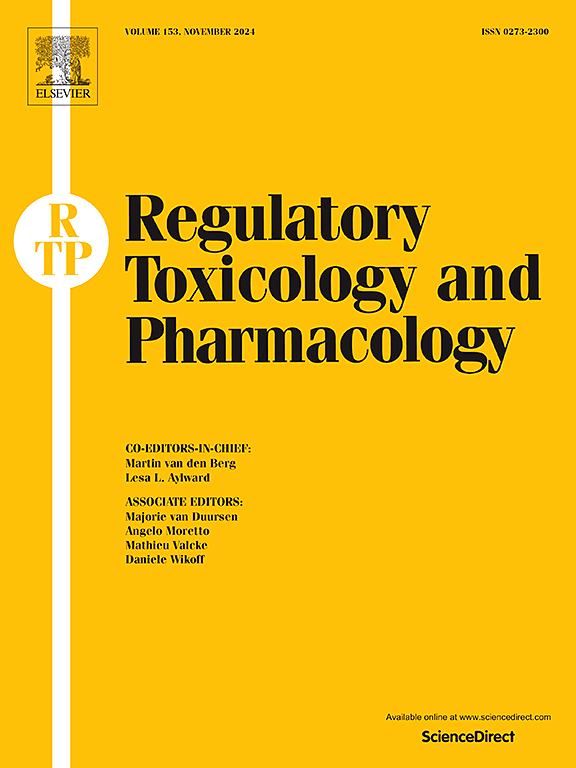Applicability of the in vitro skin irritation methods (EpiSkin™, EpiDerm™ SIT) to organosilicon-based substances
IF 3
4区 医学
Q1 MEDICINE, LEGAL
引用次数: 0
Abstract
It is now widely accepted that the reconstructed human epidermis models (OECD TG 439) can be used as a standalone replacement of the in vivo rabbit assay (OECD TG 404) to accurately predict skin irritancy. Many legislations have now introduced the legal requirement to use in vitro methods as the first step. The applicability of these methods to organosilicon-based substances was not evaluated during the validation of this guideline. Therefore, the aim of the current work was to assess the applicability of EpiSkin™ and EpiDerm™ SIT in vitro methods for organosilicons. Ten substances were evaluated, and results were compared with existing rabbit data. The data showed that both test methods failed to accurately predict the in vivo skin irritation potential, with predictive capacities below the minimum test guideline requirements. The two models delivered consistent results in only 60% of the cases. Several hypotheses were explored to explain this high rate of discordance without success. As EpiDerm™ SIT showed 100% sensitivity, a new stepwise testing strategy is proposed for organosilicons consisting of starting with EpiDerm™ SIT, following by EpiSkin™ in case of positive outcome. While keeping protective, this adapted strategy avoids unnecessary animal testing.
体外皮肤刺激方法(EpiSkin™,EpiDerm™SIT)对有机硅基物质的适用性。
现在被广泛接受的是,重建的人表皮模型(OECD TG 439)可以单独替代兔体内试验(OECD TG 404)来准确预测皮肤刺激。许多立法机构现在已经引入了使用体外方法作为第一步的法律要求。在本指南的验证过程中,没有评估这些方法对有机硅基物质的适用性。因此,本研究的目的是评估EpiSkin™和EpiDerm™SIT体外检测有机硅的适用性。对10种物质进行评价,并将结果与现有家兔数据进行比较。数据显示,两种测试方法都不能准确预测体内皮肤刺激电位,预测能力低于最低测试指南要求。这两种模型仅在60%的病例中提供了一致的结果。人们尝试了几个假设来解释这种高不一致性,但都没有成功。由于EpiDerm™SIT具有100%的灵敏度,因此提出了一种新的有机硅分步检测策略,包括从表皮™SIT开始,然后在阳性结果的情况下使用EpiSkin™。在保持保护的同时,这种适应性策略避免了不必要的动物实验。
本文章由计算机程序翻译,如有差异,请以英文原文为准。
求助全文
约1分钟内获得全文
求助全文
来源期刊
CiteScore
6.70
自引率
8.80%
发文量
147
审稿时长
58 days
期刊介绍:
Regulatory Toxicology and Pharmacology publishes peer reviewed articles that involve the generation, evaluation, and interpretation of experimental animal and human data that are of direct importance and relevance for regulatory authorities with respect to toxicological and pharmacological regulations in society. All peer-reviewed articles that are published should be devoted to improve the protection of human health and environment. Reviews and discussions are welcomed that address legal and/or regulatory decisions with respect to risk assessment and management of toxicological and pharmacological compounds on a scientific basis. It addresses an international readership of scientists, risk assessors and managers, and other professionals active in the field of human and environmental health.
Types of peer-reviewed articles published:
-Original research articles of relevance for regulatory aspects covering aspects including, but not limited to:
1.Factors influencing human sensitivity
2.Exposure science related to risk assessment
3.Alternative toxicological test methods
4.Frameworks for evaluation and integration of data in regulatory evaluations
5.Harmonization across regulatory agencies
6.Read-across methods and evaluations
-Contemporary Reviews on policy related Research issues
-Letters to the Editor
-Guest Editorials (by Invitation)

 求助内容:
求助内容: 应助结果提醒方式:
应助结果提醒方式:


